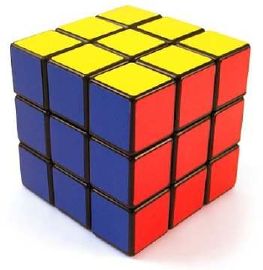2.1.3.P1
|
A. In the file cubes.pdf are two diagrams that can be cut out and folded into a 1x1x1 and a 2x2x2 cube. In the figure at the right is shown a 3x3x3 cube (the famous "Rubik's cube"). Using a single edge, a single face, and the volume of the 1x1x1 cube as "1", figure out the edge length (L), area (A), and volume (V) of the three cubes and enter them in the table below.
| Length of one edge of cube | Perimeter (L) | Area (A) | Volume (V) |
|---|
| 1 |
|
|
|
| 2 |
|
|
|
| 3 |
|
|
|
In counting the edge length of the larger cubes, only count the outer edges, not the lines making criss-crosses across each face of the cube.
|
 |
B. Given that a 0x0x0 cube has edge length, area, and volume equal to 0, graph L, A, and V and describe carefully what your graph looks like.
C. If you had a cube of side N, where N is any integer, what would be the total edge length (L), the total surface area (A), and the total volume (V). Give an equation expressing your answer for each in terms of the symbol "N".
L =
A =
V =
Explain how you got your equations.
D. According to your equations, for what value of N does L = A?
N =
For what value of N does A = V?
N =
E. Suppose you got the value of N in the parts above by measuring your cube in inches. Now convert to centimeters. If the edge of the cube in inches is N, what is it in cm? Now what are L, A, and V in terms of N? (Round your answer to the second decimal place.)
L =
A =
V =
F. Even though you found an N for which L = A when N was counted in inches, if it's counted in cm, you should have found that the equality no longer holds. What's going on? Did you make a mistake? If so, explain what it is. Or is the question fundamentally flawed? If it is, explain what's going on.
Joe Redish 9/4/10
Comments (0)
You don't have permission to comment on this page.